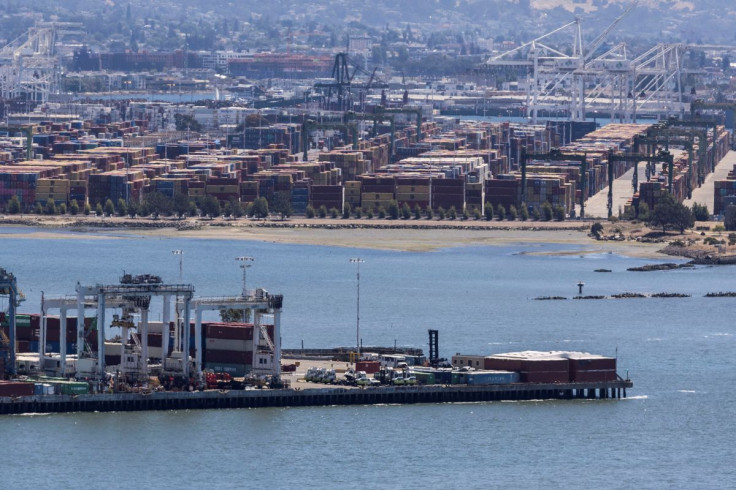U.S. Goods Trade Deficit, Business Spending Data May Salvage Second-quarter GDP

The U.S. trade deficit in goods narrowed sharply in June as exports surged, while business spending on equipment remained strong, reducing the risk that the economy contracted again in the second quarter.
The better-than-expected reports from the Commerce Department on Wednesday left economists scrambling to upgrade their gross domestic product estimates for the last quarter, which had ranged from negative to barely growing. The data were published ahead of the release on Thursday of the advance second-quarter GDP estimate.
A raft of soft housing data as well as weak business and consumer sentiment surveys had raised expectations for a second straight quarterly negative GDP reading, exacerbating worries of a recession.
JPMorgan now expects the economy grew at a 1.4% annualized rate instead of the previously forecast 0.7% pace.
"This morning's data leaves us more convinced that second-quarter GDP will not decline in tomorrow's release," said Veronica Clark, an economist at Citigroup in New York.
The goods trade deficit shrank 5.6% to $98.2 billion, the smallest since last November. Goods exports increased $4.4 billion to $181.5 billion. There were strong gains in exports of food and industrial goods. But fewer capital and consumer goods as well as motor vehicles and parts were exported.
Imports of goods fell $1.5 billion to $279.7 billion. They were pulled down by imports of motor vehicles and food. Imports of consumer and capital goods, however, increased strongly.
Trade has subtracted from GDP for seven straight quarters and the anticipated contribution to GDP from the smaller gap is likely to offset an expected drag from inventories.
While businesses continue to rebuild inventory, the pace has slowed from what was seen in the fourth quarter of 2021 and the first three months of this year. With consumer spending slowing, business are also cautious about accumulating too much stock.
Walmart on Monday said it needed more price cuts to pare inventories. Back in May, the retail bellwether said it was sitting on over $60 billion of inventory at the end of the first quarter.
The Commerce Department also reported on Wednesday that wholesale inventories increased 1.9% in June, while stocks at retailers rose 2.0%. Retail inventories were boosted by a 3.1% jump in motor vehicle stocks.
Excluding motor vehicles, retail inventories increased 1.6%. This component goes into the calculation of GDP.
"We now expect narrowing in the trade deficit in the second quarter to provide even more support for headline GDP growth than we had previously anticipated, and we also expect less of a drag from inventories than our earlier forecast," said Daniel Silver, an economist at JPMorgan in New York.
According to a Reuters survey of economists, GDP likely increased at a 0.5% annualized rate in the second quarter. The survey was conducted before Wednesday's data. The economy contracted at a 1.6% pace in the first quarter.
Investors have been nervous about another negative quarterly GDP reading, which would mean a technical recession.
But GDP is only one of the many indicators tracked by the National Bureau of Economic Research, which is the official arbiter of recessions in the United States. As such, a second straight quarter of contraction in GDP would not mean the economy was in recession.
Stocks on Wall Street were higher. The dollar was steady against a basket of currencies. U.S. Treasury prices rose.
COOLING ACTIVITY
Economic activity is cooling as the Federal Reserve aggressively tightens monetary policy to tame inflation. The U.S. central bank is expected to raise its policy rate by another 75 basis points later on Wednesday, which would bring the total interest rate hikes since March to 225 basis points.
Despite the rising interest rates and mounting recession fears, businesses are still investing in equipment. In another report on Wednesday, the Commerce Department said orders for non-defense capital goods excluding aircraft, a closely watched proxy for business spending plans, rose 0.5% last month.
These so-called core capital goods orders increased 0.5% in May. Economists polled by Reuters had forecast core capital goods orders would gain 0.2%. Orders increased 10.1% on a year-on-year basis in June.
There were big increases in orders for computers and electronic products as well as electrical equipment, appliances,
and components. But orders for machinery dipped.
Core capital goods shipments advanced 0.7% after rising 1.0% in May. Core capital goods shipments are used to calculate equipment spending in the GDP measurement.
"Some of the increase is attributed to higher prices but the absence of a sustained decline in orders suggests that businesses are still investing despite tighter financial market conditions, drop in sentiment and worries about a recession," said Ryan Sweet, a senior economist at Moody's Analytics in West Chester, Pennsylvania.
Orders for durable goods, items ranging from toasters to aircraft that are meant to last three years or more, surged 1.9% in June after rising 0.8% in May. They were boosted by a 5.1% jump in orders for transportation equipment. Motor vehicle orders increased 1.5. Orders for defense aircraft soared 80.6%.
Unfilled durable goods orders increased 0.7%, which should keep manufacturing humming for a while. Inventories rose 0.4%.
"Tighter financial conditions will make capital expenditure projects more expensive, but higher interest rates won't completely derail business investment prospects," said Lydia Boussour, lead U.S. economist at Oxford Economics in New York.
© Copyright Thomson Reuters {{Year}}. All rights reserved.





















